What are the stages of a construction project in civil engineering?
In the exciting world of engineering, a construction project is a meticulous and well-structured process essential for turning an idea into a tangible and functional work. To materialize a construction project, a series of well-defined steps must be followed, each with its own importance and specific objectives. Let’s delve into the stages of a construction project in detail:
Initiation
Everything begins with the initiation stage, the starting point for any construction project. Here, the idea is defined and authorized, taking into account various key aspects. One of the fundamental foundations is the existence of an unmet need that motivates the project’s initiation. This need can be diverse, from solving housing problems to building bridges connecting isolated areas or monuments paying tribute to historical figures.
In the next stage, analysis, a deeper examination of the previously identified needs takes place. The most relevant ones are selected, and the causes behind them are investigated. Factors such as changes in the environment, development policies, shifts in demand, obsolescence of existing infrastructure, and the creation of new infrastructure are considered to establish the project’s objectives. These objectives can be social, economic, functional, or profit-oriented.
Solution identification is the next step in this fascinating process. Here, all possible alternatives to solve the problem identified in the previous stages are explored. Creativity and imagination are encouraged to propose solutions at the conceptual level, prioritizing the search for innovative ideas without restrictions initially.
Feasibility studies become highly relevant in the project cycle. These critical stages allow determining if the proposal is viable from various perspectives, including environmental, technical, economic, administrative, and legal. Evaluating all possible alternatives is crucial to select the option that offers the best technical and economic feasibility, meeting the established requirements.
Financing is an essential element in this initial stage. Once the technical project has been decided, an evaluation of how the expenses involved in its realization will be covered takes place. Financing can come from internal resources or through loans and must be carefully planned to ensure the project’s financial success.

Planning
Planning is a crucial phase where the execution plan of a construction project is developed. In this stage, the previously established objectives are defined and refined, and the course of action is outlined. One of the fundamental aspects in this stage is the design, which will be detailed in the next section.
Design involves a meticulous creation of plans and specifications that bring the project to life. Various factors are considered, including site studies covering topographical, geological, hydrological, environmental, legal, and historical aspects. Additionally, architectural design is addressed, setting owner requirements and preparing a preliminary design that culminates in the final architectural design with plans and specifications.
Structural design is another essential component to ensure the structure can withstand the loads it will be subjected to during its lifespan. Resilient elements are determined, structural components are designed, and technical specifications and plans are configured.
Environmental impact studies focus on analyzing the project’s consequences on the environment, ensuring appropriate measures are taken to minimize any negative effects.
Facility design is equally important to provide the structure with the necessary functionality for its intended purpose. Typical facilities include electrical, gas, potable water, and sewage systems, among others.
Bidding documents are also prepared, allowing interested parties to participate in the project’s bidding process, a crucial step in selecting the most suitable contractor for the work.

Execution
Execution is the phase where everything comes to life; it is the construction phase of a previously planned project. It is one of the most exciting and challenging moments of the project, requiring meticulous integration of people and resources to execute the established plan.
Construction is the heart of this stage and represents one of the most relevant phases of the process, where the work takes shape. Various steps are established, such as defining a management and quality strategy, obtaining permits, signing contracts, planning and scheduling the work, budget studies, hiring labor, and acquiring the necessary materials and machinery.
Control and monitoring are fundamental elements in this phase to ensure everything aligns with the planned objectives. What has been accomplished is compared with the established goals, and corrective measures are applied if necessary. Control can be internal, external, or a combination of both.
For example, if we are talking about the stages of a construction project for a house, whether it’s a family home or a larger project, this is the moment when tasks like leveling, layout, cleaning, and clearing are started. For more information, you can read about Preliminary Work.
Control and Monitoring
The control and monitoring phase is essential to keep the project on track towards success. The project’s progress is regularly measured and monitored, allowing for the identification of improvement opportunities and the application of corrective measures if deviations occur along the way.
Within control and monitoring, labor productivity becomes a relevant indicator, showing the amount of work completed by an individual or team in a specific time period. Improving productivity is an ongoing pursuit to optimize processes and maximize results.
Work study also plays a significant role in this stage, analyzing the tasks and processes involved in the project. Through method analysis, time studies, and work sampling, the goal is to measure the level of activity and establish benchmarks for improvement.
Start-up
At this point, we reach the start-up phase, where the construction is handed over, and its operation begins. Before this moment, various checks are carried out to ensure the quality of the construction, including tests and trials, a detailed review of elements and finishes, and operational tests.
Operation and Maintenance
The operation and maintenance stage, often underestimated, is of utmost importance to ensure the durability and proper functioning of the work over time. Adequate maintenance of the infrastructure is fundamental and should be considered from the early design stages. This phase involves the management and conservation of the completed work.

Closing
Finally, we arrive at the project’s closing, where the acceptance of the product, service, or result is formalized. This organized stage concludes the project or a specific phase of it, marking the end of a life cycle filled with challenges, achievements, and learning experiences.
For more structured and specific information about the steps to follow in each of the stages and to learn about all the types of preliminary tests, necessary designs, and plans, you can visit the Project Life Cycle.
Related topics: Engineering Project and Construction Project.
About The Author
Samuel Parariá
Estudio: University of Francisco de Paula Santander.
Major: Civil Engineering.
Favorite Areas: Structures, Traffic Engineering, and Road Design.
Location: Cúcuta, Norte de Santander, Colombia.







Related
Gravity Retaining Walls
What are Anchored Retaining Walls?
Methods for Paver Calculation – Civil Engineering